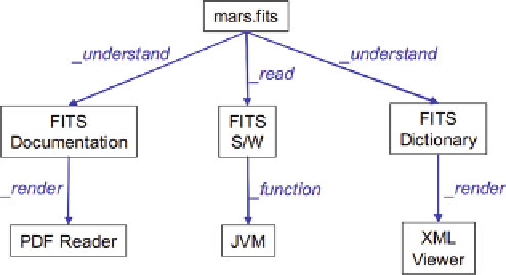Information Technology Reference
In-Depth Information
Fig. 8.4
Modelling the dependencies of a FITS file
According to the model, data are modelled as modules, while derivation edges
are modelled as dependencies (important for the aforementioned tasks). Similarly,
this model allows a straightforward modelling of an OAIS Representation Network
(Fig.
6.4
), since the notion
interpretedUsing
can be considered as a specialized form
of dependency. In addition, a module can have several dependencies of different
types. For example, Fig.
8.4
illustrates the dependencies of a file in
FITS
format
where boxes denote modules and arrows denote dependencies of different types
(the starting module depends on the ending module; the label denotes the type of
the dependency. The file
mars.fits
can be read with an appropriate application
which is modelled with the
FITS S/W
module. This in turn requires the availabil-
ity of Java Virtual Machine in order to function. If our aim is to understand the
concepts of the file then we must have available the
FITS
Documentation and the
FITS
Dictionary. These files are in PDF and XML format and therefore require,
for example, the existence of the appropriate application that renders their con-
tents. Such a dependency graph provides a richer view of an OAIS Representation
Network (recall Sect.
6.3.1
), since it allows the definition of dependencies of various
interpretations.
8.2.1.1 Conjunctive Versus Disjunctive Dependencies
Usually there are more than one ways to perform a task. For example for reading
the file
HelloWorld.java
a text editor is required, say
NotePad
. However we
can read this file using other text editors, e.g.
VI
. Therefore, and for the task of
readability, we could say that
HelloWorld.java
depends on
NotePad
OR
VI
.
However, the dependencies considered so far are interpreted conjunctively, so it
is not possible to capture the above scenario. The disjunctive nature of dependencies
was first approached at [
116
] using the concept of generalized module (which is a
set of modules interpreted disjunctively) but the management of such modules was
rather complex.
A clearer model, based on Horn Rules, which also allows the defining the prop-
erties (e.g. transitivity) of dependencies straightforwardly, was presented in [
117
].

